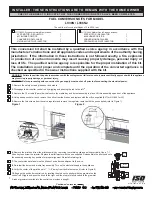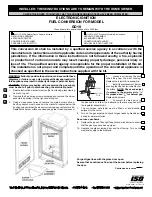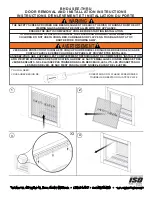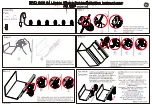
Note
TB3 terminal block has 12 terminals to
accommodate up to four Microcells™ (A, B,
C, and D). Locate the terminal labeled for the
Microcell™ you are wiring.
5. Estimate the required length of cable to the
terminal strip, allowing a little extra for strain
relief. Cut the excess cable.
6. Strip back 3 in (76mm) of the cable sheathing
to expose the three wires inside. Strip back
¼” (6mm) of insulation from the end of each of
the wires.
7. Connect the wires from the Microcell™ to the
selected TB3 terminals; black wire to B
terminal, white wire to W terminal, and red wire
to R terminal.
8. Perform Steps 2 through 7 for each Microcell™
you wire to this junction box (up to four).
9. Spread a generous bead of sealant (Sikaflex
1A polyurethane sealant or Dow Corning RTV
738 or RTV 739) around the sides of the plug
for each hole not being used. Screw a plug
into each hole.
10. Replace the junction box cover and screws
if not ready to begin wiring the junction boxes
together to ensure that no moisture enters the
junction box.
WIRING JUNCTION BOXES
TOGETHER AND TO
SIGNAL PROCESSOR
There are two versions of the junction box
enclosure. Both versions have four small holes
for wiring Microcells™ to the junction box, as
described previously. In addition, the junction box
has one or two large holes:
1. One large hole for conduited installation. The
large hole, which accommodates a ¾” conduit
fitting, is for wiring the junction box to the other
junction boxes and to the signal processor.
2. Two large holes for non-conduited
installation. The two large holes, which are
equipped with PG13.5 cable fittings, are for
wiring the junction box to the other junction
boxes and to the signal processor.
Kistler-Morse
®
requires the use of cable
trays for non-conduited installations.
Note
A. The following procedure assumes the
conduit/cable tray has been installed.
B. Seal all conduit fittings against water
entry. Install drain holes at the conduit’s
lowest elevation(s) to allow condensation
to drain.
C. Use Belden™ 3-conductor shielded
interconnect cable or equivalent to wire
junction boxes together and to the signal
processor. For lengths up to 1,000 ft
(305m), use 18 gauge Belden™ 8791 cable.
For lengths from 1,000 ft to 2,000 ft (305m
to 610m), use 16 gauge Belden™ 8618
cable.
D. When wiring cable to junction box
terminals, strip back 3 in (76mm) of cable
sheathing to expose the 3-conductor wires
and shield wire inside. Strip ¼” (6mm) of
insulation from the end of each of the
conductor wires.
E. All wiring routed between the junction
boxes and signal processor must be
continuous with no splices.
CAUTION
Only use Sikaflex 1A polyurethane sealant or
Dow Corning RTV 738 or RTV 739.
Other
sealants may contain acetic acid, which is
harmful to sensors and electronics.
1. Remove the junction box cover.
For a conduited installation, install a conduit
fitting in the large hole in the bottom of the
junction box.
For a non-conduited installation, See Figure
3-14. Spread a generous bead of sealant
around the sides of the PG13.5 cable fittings.
Install the fittings in the two large holes in the
bottom of the junction box.
Figure 3-14. Inserting Shielded Interconnect
Cable Through PG13.5 Fitting and Cap.
13
Содержание Microcell
Страница 20: ...Figure 3 18 Cutting Wrap Width Figure 3 19 Installing Brace Wrap 16 ...
Страница 22: ...Figure 4 2 Microcell Mounting Locations 18 ...
Страница 30: ...Figure 4 16 Wiring Junction Boxes Together Non Conduited Installation 26 ...
Страница 37: ...33 ...
Страница 42: ...38 ...
Страница 43: ......















































